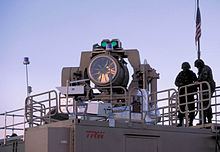
Back سلاح الليزر Arabic Лазэрная зброя BE-X-OLD Arma láser Spanish سلاح لیزری Persian נשק לייזר HE レーザー兵器 Japanese 레이저 무기 Korean Лазердик курал Kirghiz Laservåpen NB Лазерное оружие Russian

A laser weapon[2] is a type of directed-energy weapon that uses lasers to inflict damage. Despite decades of research and development, as of 2023[update], directed-energy weapons, including lasers, remain at the experimental stage. Whether they will be deployed as practical, high-performance military weapons remains to be seen.[3][4] One of the major issues with laser weapons is atmospheric thermal blooming, which is still largely unsolved. This issue is exacerbated when there is fog, smoke, dust, rain, snow, smog, foam, or purposely dispersed obscurant chemicals present. In essence, a laser generates a beam of light that requires clear air or a vacuum to operate.[5]
Several types of laser have been identified as having the potential to be used as incapacitating non-lethal weapons. They can cause temporary or permanent vision loss when directed at the eyes. The extent, nature, and duration of visual impairment resulting from exposure to laser light depend on various factors, such as the laser's power, wavelength(s), collimation of the beam, orientation of the beam, and duration of exposure. Even lasers with a power output of less than one watt can cause immediate and permanent vision loss under certain conditions, making them potential non-lethal but incapacitating weapons. However, the use of such lasers is morally controversial due to the extreme handicap that laser-induced blindness represents. The Protocol on Blinding Laser Weapons bans the use of weapons designed to cause permanent blindness. Weapons designed to cause temporary blindness, known as dazzlers, are used by military and sometimes law enforcement organizations. Incidents of pilots being exposed to lasers while flying have prompted aviation authorities to implement special procedures to deal with such hazards.[6]
Laser weapons capable of directly damaging or destroying a target in combat are still in the experimental stage. The general idea of laser-beam weaponry is to hit a target with a train of brief pulses of light. The United States Navy has tested the very short-range (1 mile), 30-kW Laser Weapon System or LaWS to be used against targets like small UAVs, rocket-propelled grenades, and visible motorboat or helicopter engines.[7][8] It has been defined as "six welding lasers strapped together." A 60 kW system, HELIOS, is being developed for destroyer-class ships as of 2020[update].[9]
- ^ "US and Israel Shelved Laser as a Defense". The New York Times. 30 July 2006.
- ^ "Directed Energy".
- ^ Ghoshroy, Subrata (18 May 2015). "Navy's new laser weapon: Hype or reality?". Bulletin of the Atomic Scientists. Retrieved 17 January 2020.
- ^ Hecht, Jeff (27 September 2017). "Laser Weapons Not Yet Ready for Missile Defense". IEEE Spectrum. IEEE. Retrieved 17 January 2020.
- ^ Atherton, Kelsey D. (27 June 2017). "Here come the helicopters with weaponized lasers". Popular Science. Retrieved 17 January 2020.
- ^ Symonds, Tom (8 April 2009). "Police fight back on laser threat". BBC News. Retrieved 17 January 2020.
- ^ Luis Martinez (9 April 2013). "Navy's New Laser Weapon Blasts Bad Guys From Air, Sea". ABC. Retrieved 9 April 2013.
- ^ "The U.S. Army Plans to Field the Most Powerful Laser Weapon Yet". 7 August 2019.
- ^ "When it comes to missile-killing lasers, the US Navy is ready to burn its ships". 28 May 2019.
© MMXXIII Rich X Search. We shall prevail. All rights reserved. Rich X Search